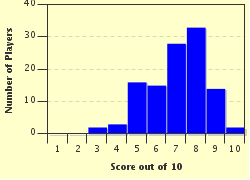Quiz Answer Key and Fun Facts
1. Technically known as a parhelion, what is the more common name for this type of atmospheric phenomenon?
2. In which of these locations are you most likely to experience an aurora?
3. Which of the following is the name of the clear or white rainbow-like effect often seen on misty days?
4. Which of the following locations, on average, has the most lightning strikes per year?
5. What is the name for the lighting phenomenon that is seen as a bright red light over the top a thunderstorm?
6. Volcanic eruptions are often seen with bolts of lightning.
7. Sunbeams like those in the photo are properly known as crepuscular rays.
8. What does a yellow sky generally mean?
9. Which of the following options is an illusion, without substance or reality?
10. What is the common term for this whirlwind of dust in the wind?
Source: Author
dcpddc478
This quiz was reviewed by FunTrivia editor
rossian before going online.
Any errors found in FunTrivia content are routinely corrected through our feedback system.

